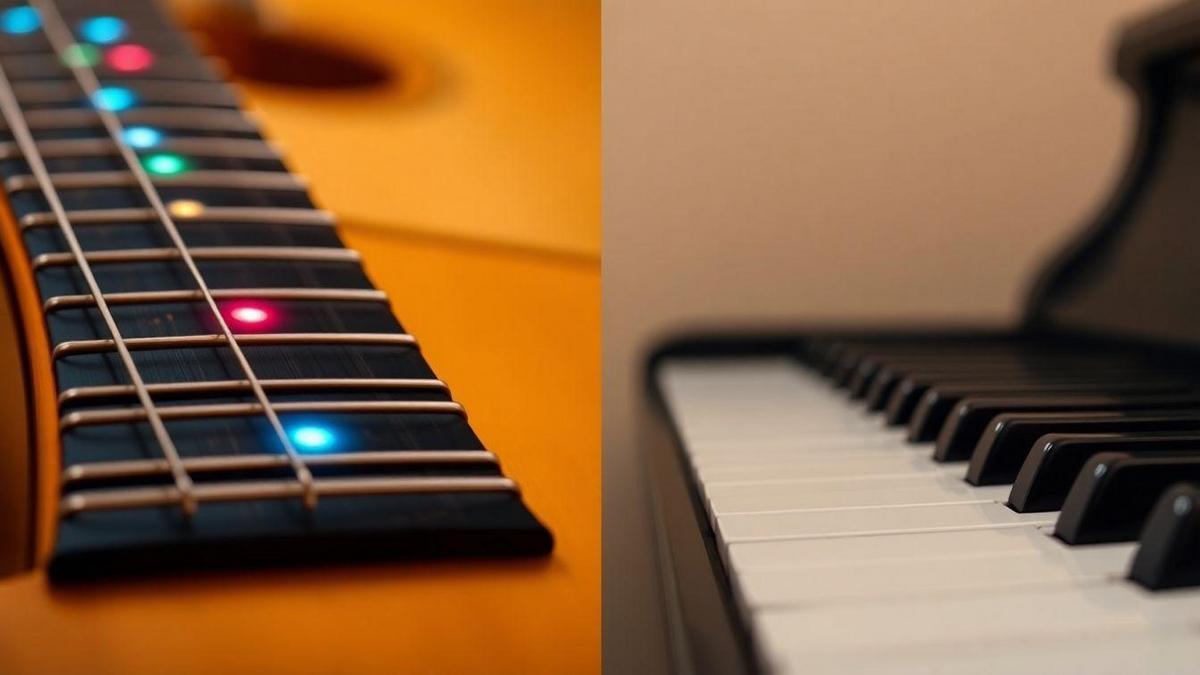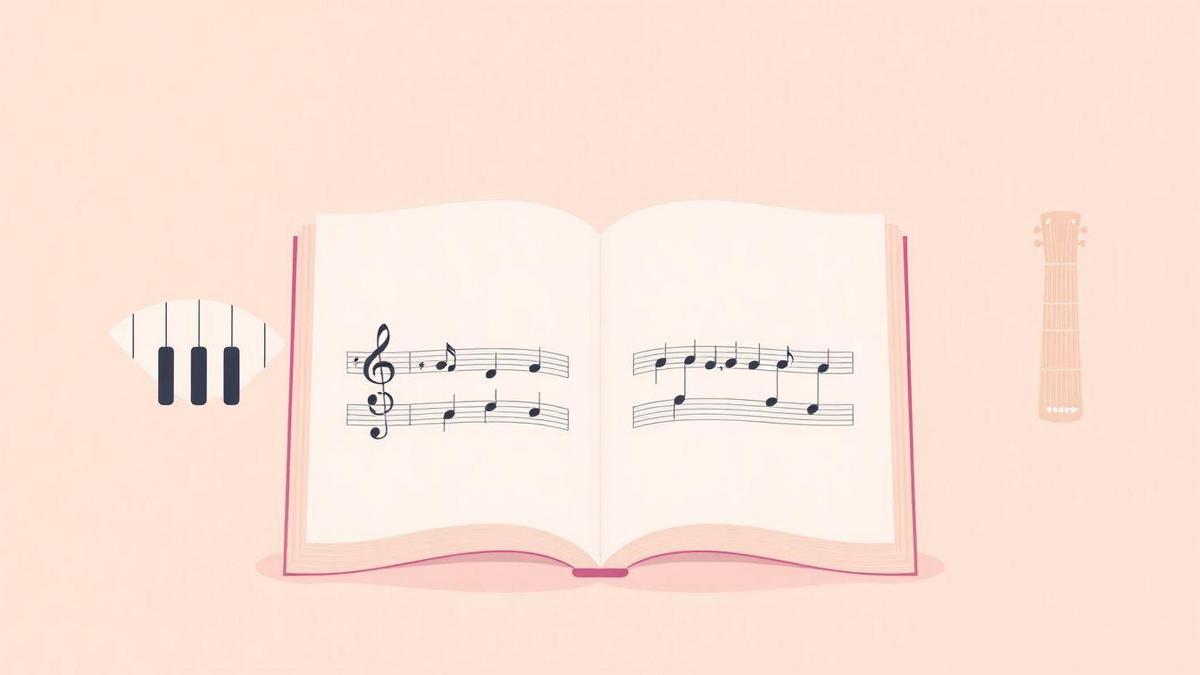Scales explained in plain English — I make scales simple
Scales explained in plain English — I show what a scale is and why it helps you make melodies and chords. I explain key words like tone, semitone, and interval. I give a simple step-by-step plan, break scales into small chunks, and share daily habits for guitar and piano practice. I make major and minor easy, map scales to chords, show shapes on the fretboard and keyboard, and add quick warmups and improv tips so you can play with confidence.
Key takeaway
- Learn the order of notes in each scale.
- Practice scales slowly with a metronome.
- Use scales to create melodies and match chords.
- Break scales into small groups to memorize them.
- Play scales in many keys to build fluency.

Scales explained in plain English — what are musical scales in simple terms
How I explain a scale: an ordered set of notes
A scale is an ordered set of notes you can reach for when you play or write. The first note is the root. The order tells you which notes sound good together. For example, the C major scale is C D E F G A B C. Use that list like a recipe: pick notes from it to make a melody.
Degree | Note
- –|—
1 (root) |
C
2 | D
3 | E
4 | F
5 | G
6 | A
7 | B
8 (octave) | C
A scale follows a pattern of steps. For a major scale the pattern is whole, whole, half, whole, whole, whole, half. A whole step = two piano keys (or two frets); a half step = one key (or one fret). Play the scale up and down until the order feels like a map under your fingers. For a concise overview, see Clear introduction to musical scale concepts.
If you want to take the mystery out of music basics, a gentle next read is Is music theory really that scary?, which frames theory as practical tools rather than intimidating rules.
Why knowing scales helps you make melodies and chords
Knowing a scale gives you a clear set of notes that fit together. That speeds up melody writing and makes building chords simple: stack every other note from the scale (1, 3, 5) to make a triad. Want a bright sound? Use a major scale. Want a sadder mood? Use a minor scale.
For a deeper look at how chords are built and why they matter in songs, see What chords are and why they matter, and for reading chord symbols and notation, try How to read chords and sheet music.
Practice habits I use:
- Pick notes from the scale to make motifs. Short patterns repeat and stick.
- Form chords from scale degrees to keep harmony clean.
- Improvise within one scale to reduce wrong notes and boost confidence.
Quick exercise: pick a scale, play the root, then the 3rd and 5th. Hum a melody using only those notes — you’ll hear how the scale controls the mood.
Key terms: tone, semitone, interval
Term | Simple meaning | Example
- –|—:|—
Tone (whole step) | Two half steps | C → D
Semitone (half step) | The smallest step, one piano key | E → F
Interval | The distance between two notes | C to E = a third
I bold these words when I teach so students spot them fast. Remember: a tone is bigger than a semitone. An interval names how far apart notes are. For hands-on exercises that show intervals and steps clearly, try Simple lessons on intervals and steps.
How to learn scales step by step
My simple daily plan (15–25 minutes)
I keep practice short so it happens. Pick one scale, one goal, and one small exercise. Make noise, listen, and slow down when you make mistakes.
- Warm-up: 5 minutes — play the scale slowly and sing one note.
- Focus block: 10 minutes — drill one chunk or pattern.
- Musical use: 5–10 minutes — play with a backing track or improvise.
Stage | Time | Purpose
- –|—:|—
Warm-up | 5 min | Set
tempo, check fingerings
Focus block | 10 min | Drill the small chunk
Musical use | 5–10 min | Apply the scale in a song or jam
Short, consistent practice wins — the idea behind The power of just twenty minutes daily is the same: measurable, repeatable progress. For structured resources and exam-focused scale guidance, see Practice-focused guidance and scale resources.
If practice feels like a chore, try some ideas from Making practice fun instead of a chore to keep momentum.
Rule: stop when tone drops or fingers tense; pick up the same chunk the next day.
How I break a scale into small, repeatable chunks
I break the scale into bite-size pieces so brain and hands learn together. Start with one octave or 3–4 note patterns, repeat until easy, then add the next chunk.
Steps:
- Learn the scale formula (e.g., W-W-H for the start of a major).
- Play one octave up/down slowly.
- Split the octave into two or three short groups.
- Link groups and repeat until smooth.
- Add a rhythm or short melody using the same notes.
Chunk | Example (C major) | Practice tip
- –|—|—
Chunk A | C – D – E | Play slowly, sing the middle note
Chunk B | E – F – G | Loop 10 times, change rhythm
Link AB | C – D – E – F – G | Connect smoothly, add a riff
Use rhythms (quarter, two eighths, quarter) to make chunks feel like phrases. Practice small sequences (e.g., 1-3-2-4) to build finger paths.
Set reachable goals and track small wins
Write tiny goals and log them. Small wins keep momentum.
Week | Goal | Measure
- –|—|—
1 | Learn Chunk A clean | 10 passes at 60 BPM
2 | Link AB | 8 passes at 70 BPM
3 | Play with backing track | 3 short jams
4 | Improvise 1 minute | Notice confidence and smoothness
Log: date, scale, chunk, tempo, win. When the metronome moves up, celebrate.
If you struggle with getting started or procrastinate, the piece on How to stop procrastinating on music practice has practical nudges to make sessions happen. To build a repeatable plan, see How to create simple practice routine daily.
Understanding major and minor scales made easy
Spot the major pattern quickly: W‑W‑H‑W‑W‑W‑H
Treat the major scale like a staircase: W‑W‑H‑W‑W‑W‑H (W = two frets/keys, H = one). Pick a root, follow the pattern, sing “do‑re‑mi” as you go.
Degree | Step from previous | C major note
- –|—:|—
1 (tonic) | – |
C
2 | W | D
3 | W | E
4 | H | F
5 | W | G
6 | W | A
7 | W | B
8 (octave) | H | C
Fretboard rule: two frets = W, one fret = H. Use it to build scales on the fly.
Hear minor vs major by the third
The third tells the mood:
- If the third is 4 semitones above the root → major.
- If the third is 3 semitones above the root → minor.
Quick ear test:
- Play root third together. Bright → major; darker → minor.
- C E = C major; C E♭ = C minor.
- A major triad (1–3–5) confirms major; a minor triad (1–♭3–5) confirms minor.
To learn how small changes in pitch create emotion, see How to add emotion to every note, and for why certain progressions give goosebumps, read Why do some songs give us goosebumps?.
Relative major and minor in one rule
The relative minor is the 6th degree of its major scale (or go down three semitones from the major tonic).
Major key | Relative minor
- –|—
C major | A minor
G major | E minor
F major | D minor

Practical tips for guitar and piano
Pick fingerings that fit the instrument
Choose fingerings that make the line feel like a conversation—not a wrestling match.
Guitar:
- Favor fingerings that keep the hand in one position.
- Use open strings for ringing notes.
- Think in terms of strings and positions to avoid big shifts.
Piano:
- Use fingerings that allow legato and steady hand shape.
- Plan thumb passes to break long runs into smooth segments.
- Break phrases into short groups to avoid awkward stretches.
Goal | Guitar tip | Piano tip
- –|—|—
Smooth legato | Use
hammer-ons, slide positions | Use thumb to flow
Fewer shifts | Favor open strings, compact shapes | Group notes into 3–4 patterns
Repeatable speed | Match picking hand | Avoid wrist twisting
If you’re choosing an instrument or helping a beginner get started, check 5 affordable instruments perfect for beginners for practical options.
Test fingerings slowly and choose the most repeatable, tension-free option.
Small habits to build speed and accuracy
I stack steady layers: warm-up, isolate hardest bars, drill short chunks.
Habits:
- Slow practice: every note clean.
- Chunking: 3–4 note patterns.
- Micro-goals: clean 8 bars, not a marathon.
- Alternate drills: switch between speed and accuracy.
Drill | Time | Tempo plan
- –|—:|—
Warm-up | 5 min | Comfortable slow
Targeted chunk | 10 min | Start slow → 5% every 3 reps
Full scale sweep | 5 min | Play cleanly at target tempo
Use the metronome, relax wrists, and repeat slowly. If wrists tense, stop and shake them out.
Step-by-step:
- Set metronome to a slow, clean tempo.
- Play one bar cleanly; stop on mistakes.
- Repeat the bar 6–8 times before moving on.
- Raise tempo only when clean.
- Breathe and keep hands loose.
If practice motivation wanes, Overcoming the fear of starting music and Talent vs practice: can anyone learn music? offer encouragement and perspective.
How scales connect to chords and melodies
Scales explained in plain English — start with one scale, see the chords that come from it, then pick melody notes that fit those chords. Keep it practical.
Map scale notes to chord tones to build strong melodies
Find the chord’s 1, 3, and 5 first — those are the chord tones. Aim your melody at those notes on strong beats; use other scale notes as passing tones.
Chord | Chord tones (strong) | Good melody moves
- –|—|—
C (I) |
C, E, G | Start/land on C/E; use D as a step
F (IV) | F, A, C | Target A for brightness; use G to lead
G (V) | G, B, D | Land on B to push back to C; passing A works
Simple steps to turn scale notes into song ideas:
- Pick a scale and one or two chords.
- Write chord tones (1, 3, 5).
- Hum short phrases that land on those tones on strong beats.
- Add passing notes from the scale.
- Repeat and tweak until a hook sticks.
For a textbook-style explanation of how scales connect to harmony, see Explains scales, chords, and harmony.
For more on how chords function in a progression and practical songwriting tips, see What chords are and why they matter.
Match scale degree to chord function
Scale degree | Role | How I use it in melody
- –|—|—
1 (tonic) |
Home | Strong landing; feels resolved
3 (mediant) | Color | Gives major/minor character
5 (dominant) | Support | Solid anchor
2 & 4 | Passing | Move between chord tones
6 | Flavor | Great for hooks, emotional
7 | Push | Tension that wants to resolve to 1
Aim 1, 3, or 5 on strong beats; use others as connectors.

Visual guide: fretboard and keyboard
Read and learn scale shapes on the guitar neck
Find the root first, then learn one shape at a time. I use semitone numbers: 0, 2, 4, 5, 7, 9, 11, 12 and say them out loud while I play.
Degree | Interval (semitones) | Fret from root (A at 5th fret)
- –|—:|—
1 (root) | 0 | 5
2 | 2 | 7
3 | 4 | 9
4 | 5 | 10
5 | 7 | 12
6 | 9 | 14
7 | 11 | 16
8 (octave) | 12 | 17
Practice tips:
- Mark the root on the fretboard.
- Learn one box shape, then link it to the next.
- Play the scale up/down, then skip notes to practice melodies.
- Practice with one finger on the root string to keep focus.
This is how I get “Scales explained in plain English” into hands and ears.
Find and label scale notes on the piano keyboard
Start with the root and count half steps. C major is great for beginners because it uses only white keys. Say each degree out loud: 1 (C), 2 (D), 3 (E), etc.
Degree | Note | Key color
- –|—|—
1 | C | White
2 | D | White
3 | E | White
4 | F | White
5 | G | White
6 | A | White
7 | B | White
8 | C (octave) | White
For other keys, move the W-W-H-W-W-W-H pattern. Drills:
- Play one octave, hands separately, slow.
- Sing the scale degree while you play.
- Label black keys only when they appear in the scale.
- Map scale notes to a song melody you know.
Trace shapes with your finger to build visual memory: trace slowly (look), trace with eyes closed, trace while humming the root. Five minutes a day beats long, unfocused practice.
Common scale patterns every musician should know
I focus on four practical scales — they cover most songs and solos.
Scale | Sound | Basic formula | Where it fits
- –|—|—|—
Major | Bright, happy | W W H W W W H | Pop, folk, many melodies
Natural minor | Sad, moody | W H W W H W W | Ballads, minor-key songs
Pentatonic | Simple, strong | 1 2 3 5 6 (five notes) | Rock solos, folk, vocals
Blues | Gritty, tense | Pentatonic ♭5 | Blues, rock, soul solos
Why these appear everywhere:
- Major/minor match what our ears expect.
- Pentatonic omits tense notes, making it safe over many chords.
- Blues adds the blue note (♭5) for emotion and bite.
Learn five pentatonic shapes and link them
Five common pentatonic “box” shapes let you move around the neck fluidly.
Box | Key idea | Practice
- –|—|—
Box 1 | Root-centric | Play up/down, emphasize root
Box 2 | Moves upward | Slide between Box 1 & 2
Box 3 | Higher register | Repeat short licks
Box 4 | Bridges positions | Find shared notes with Box 3
Box 5 | Leads back to Box 1 | Close the loop
Connect boxes by finding shared notes and practicing short licks that cross borders.

Using scales to improvise and solo with confidence
Pick the right scale for a chord progression
Name the chord and its quality, then match a scale that contains the chord tones.
Checklist:
- Find the root.
- Note the quality (major, minor, dominant).
- Match a scale that shares the chord’s chord tones.
Quick scale picks:
- Major for major chords.
- Natural minor or Dorian for minor chords.
- Mixolydian for dominant (V7) chords.
- Pentatonic / blues for rock/blues solos.
Chord type | Quick scale pick | Why it works
- –|—|—
Major |
Major scale | Contains 1-3-5
Minor | Minor or Dorian | Matches 1-b3-5
Dominant 7 | Mixolydian | Lowers 7 to match b7
Any bluesy feel | Minor pentatonic / blues | Simple grit for bends/slides
When you want phrasing that really moves people, the emotional side of notes is worth exploring—see How to add emotion to every note and Why do some songs give us goosebumps? for inspiration.
Phrasing tips: space, rhythm, target chord tones
Treat solos like talking. Leave space. Focus on rhythm more than speed. Target chord tones on strong beats to make lines land.
Habits:
- Play a short motif, repeat, then change one note.
- Rest for one beat after a phrase.
- Use syncopation to add surprise.
- Bend/slide into chord tones for emotion.
Practice targeting chord tones on beats 1 and 3 in 4/4. Silence teaches phrasing.
Beat | Role | What I do
- –|—|—
1 (strong) | Anchor | Land a
chord tone
2 (weak) | Connect | Passing or rhythmic fill
3 (strong) | Resolve | Hit another chord tone or rest
4 (weak) | Breathe | Leave space or small filler
Quick exercises to master scales fast
Scales explained in plain English — short drills you can do now.
Three-minute warmup to lock scale patterns
Time | Focus | Action
- –|—|—
0:00–0:30 |
Position | Play scale slowly up/down, 4 notes per beat
0:30–1:30 | Speed | Eighth notes, steady pulse, one octave
1:30–2:15 | Accent | Accent every 3rd note
2:15–3:00 | Target | Play only strong beats, stop on tonic
Vary rhythm, direction, and spacing
Drill type | Example | Why it works
- –|—|—
Rhythm | Long-short-short (quarter, eighth, eighth) | Forces attention to timing
Direction | Up two, down one, repeat | Builds interval memory
Spacing | Skip every other note (3rds) | Helps hear chord tones inside the scale
Rotate these drills across days to keep scales fresh.
Count, sing, play every day
- Count beats out loud (“1 and 2 and…”).
- Sing or hum the scale degrees before you play.
- Play slowly, matching voice and count.
If you miss a note, stop and repeat. Short perfect reps beat long sloppy runs.
If you want structure and motivation, pieces like How to create simple practice routine daily and Making practice fun instead of a chore give quick, actionable tweaks to your routine.
Scales explained in plain English — quick checklist
- Pick one scale and one chunk.
- Warm up 3–5 minutes.
- Drill the chunk slowly with a metronome.
- Sing the scale degrees while you play.
- Apply the chunk in a 1–2 minute jam.
- Log the session: date, scale, chunk, tempo, one win.
Repeat daily. Small habits = steady progress.
Conclusion
A scale is an ordered set — a roadmap you use to write melodies and build chords. Think of it as the toolbox under your seat: pick the right tool and the job gets easier.
Practice smart, not long. Keep sessions to 15–25 minutes, break things into chunks, use a metronome, and mark tiny wins. Slow, steady reps beat frantic runs. Map scale degrees to chord tones so your lines land where they should. Use the pentatonic and blues shapes for quick answers in jams. Phrase like you talk: leave space, aim chord tones on strong beats, and tell a musical story.
Put these ideas into practice today: one scale, one chunk, one short jam. If you want more clear, usable guides to keep learning, start with Is music theory really that scary? or explore the other practical posts linked throughout this guide.

5 comentários em “Scales explained in plain English for Musicians”